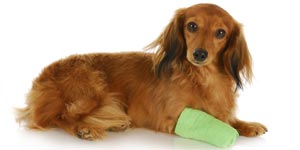
Dogs can get themselves into all kinds of trouble and can cause themselves serious injury when they’re exploring or digging. The good news is that injuries don’t necessarily need to land you in the nearest veterinary office if you know what to look for and are comfortable administering some basic first aid.
Swollen paws can result from many different accidents and can be caused by anything from bug bites or bee stings to broken toes or feet. In order to determine how to treat a swollen paw, you need to learn how to assess how serious the damage may be.
First, watch how your dog is reacting to the injury. Is he crying in pain? Is he limping? Is he pawing or chewing the affected foot? Is there swelling anywhere else? Each of these types of responses will clue you in to what’s going on.
Break or strain?
If your dog cries out in pain when you attempt to touch the injury and refuses to walk on it, odds are there’s something serious going on and x-rays are probably warranted. If it does attempt to put weight on the injury but is limping, then the foot is probably not broken but may simply be strained instead.
A strain is something you can treat at home. First aid for such an injury is bed rest and ice packs. You can also administer aspirin. Aspirin will reduce both swelling and the amount of pain the dog is experiencing, but keep in mind that the key is to have the dog stay off the injury. Because of the way dogs respond to pain, your pet is more likely to be still and rest if he’s experiencing at least some pain; also, just like any drug, aspirin can be dangerous in excess – so don’t give in to the temptation to administer more than the recommended dose.
Try to get the dog to allow you to wrap his foot in ice packs. Sitting with him and brushing him while holding his foot in the ice packs may convince him to hold still for a while. If he keeps pulling his foot out of the ice packs, simple rest will help.
If the pain and swelling don’t decrease after a few days of rest, take him to the veterinarian, as it is possible that he has experienced a hairline fracture.
Insect bites and foreign objects
If your dog appears to be agitated by the injury and tries to chew or shake the paw, it is possible that he has been bitten by an insect or the paw has something in it. Calm the dog and then thoroughly examine the paw. Remember to check between the pads and up the ankle. Inspect the entire paw both visually and by touch, feeling for anything that feels out of place. You may feel a bump where a potential bite may have occurred or a foreign object embedded in the pad. The dog may also try to pull his paw away when you touch the object.
If an object is embedded, gently remove it using a pair of tweezers. Clean the wound with warm soapy water, then treat with antibiotic ointment (like Neosporin) and wrap. The dog might find the wrap uncomfortable and attempt to remove it. If he is successful, do what you can to keep the wound clean until it heals.
If you suspect a bug bite or a bee sting, check whether your dog is swelling anywhere else, especially around the face and tongue. This will alert you to a potential life threatening allergic reaction known as anaphylaxis. If your dog is starting to swell, rush him to a veterinarian immediately. If not, attempt to clean the paw and possibly remove a stinger, if one is present. Do your best to keep him from chewing his paw and causing more damage. You can wrap it if you think it will help. You can also purchase an Elizabethan collar, which will block your dog’s attempts to chew his paw.
